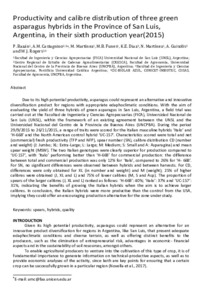Por favor, use este identificador para citar o enlazar este ítem:
https://repositorio.uca.edu.ar/handle/123456789/9625| Campo DC | Valor | Lengua/Idioma |
|---|---|---|
| dc.contributor.author | Bazán, P. | es |
| dc.contributor.author | Castagnino, Ana María | es |
| dc.contributor.author | Martínez, M. | es |
| dc.contributor.author | Funes, M. B. | es |
| dc.contributor.author | Díaz, K. E. | es |
| dc.contributor.author | Martínez, N. | es |
| dc.contributor.author | Guisolis, Andrea | es |
| dc.contributor.author | Rogers, W. J. | es |
| dc.date.accessioned | 2020-04-02T18:52:35Z | - |
| dc.date.available | 2020-04-02T18:52:35Z | - |
| dc.date.issued | 2018 | - |
| dc.identifier.citation | Bazán, P. et al. Productivity and calibre distribution of three green asparagus hybrids in the province of San Luis, Argentina, in their sixth production year (2015) [en línea]. Acta Horticulturae. 2018, 1223. doi:10.17660/ActaHortic.2018.1223.25 Disponible en: https://repositorio.uca.edu.ar/handle/123456789/9625 | es |
| dc.identifier.issn | 0567-7572 (impreso) | - |
| dc.identifier.issn | 2406-6168 (online) | - |
| dc.identifier.uri | https://repositorio.uca.edu.ar/handle/123456789/9625 | - |
| dc.description.abstract | Abstract: Due to its high potential productivity, asparagus could represent an alternative and innovative diversification product for regions with appropriate edaphoclimatic conditions. With the aim of evaluating the yield of three hybrids of green asparagus in San Luis, Argentina, a field trial was carried out at the Facultad de Ingeniería y Ciencias Agropecuarias (FICA), Universidad Nacional de San Luis (UNSL), within the framework of an existing agreement between the UNSL and the Universidad Nacional del Centro de la Provincia de Buenos Aires (UNCPBA). During the period 29/9/2015 to 26/11/2015, a range of traits were scored for the Italian masculine hybrids ‘Italo’ and ‘H-668’ and the North American control hybrid ‘UC-157’. Characteristics scored were total and net (commercial) fresh productivity (TFP and NFP), spear number (SN), calibre distribution CD (number and weight) (J: Jumbo; XL: Extra-Large; L: Large; M: Medium; S: Small and A: Asparagina) and mean spear weight (MSW). The two Italian genotypes were clearly superior for production compared to ‘UC-157’, with ‘Italo’ performing better than ‘H-668’ for commercial production: the difference between total and commercial production was only 12% for ‘Italo’, compared to 26% for ‘H-668’. For SN, no significant differences were observed between hybrids and between harvests. For CD, differences were only obtained for XL (in number and weight) and M (weight); 25% of higher calibres were obtained (J, XL and L) and 75% of lower calibres (M, S and Asp). The proportion of spears of the larger calibres (J, XL and L) ranked as follows: ‘H-668’: 40%; ‘Italo’: 37% and ‘UC-157’: 31%, indicating the benefits of growing the Italian hybrids when the aim is to achieve larger calibres. In conclusion, the Italian hybrids were more productive than the control from the USA, implying they could offer an encouraging production alternative for the zone under study. | es |
| dc.format | application/pdf | es |
| dc.language.iso | eng | es |
| dc.publisher | International Society for Horticultural Science | es |
| dc.rights | Acceso abierto | * |
| dc.rights.uri | http://creativecommons.org/licenses/by-nc-sa/4.0/ | * |
| dc.source | Acta Horticulturae. 2018, 1223 | es |
| dc.subject | ASPARAGUS | es |
| dc.subject | HIBRIDOS | es |
| dc.subject | RENDIMIENTO DE CULTIVOS | es |
| dc.subject | CALIBRE | es |
| dc.title | Productivity and calibre distribution of three green asparagus hybrids in the province of San Luis, Argentina, in their sixth production year (2015) | es |
| dc.type | Artículo | es |
| dc.identifier.doi | 10.17660/ActaHortic.2018.1223.25 | - |
| uca.disciplina | CIENCIAS AGRARIAS | es |
| uca.issnrd | 1 | es |
| uca.affiliation | Fil: Bazán, P. Universidad Nacional de San Luis. Facultad de Ingeniería y Ciencias Agropecuarias; Argentina | es |
| uca.affiliation | Fil: Castagnino, Ana María. Pontificia Universidad Católica Argentina. Facultad de Ingeniería y Ciencias Agrarias; Argentina | es |
| uca.affiliation | Fil: Castagnino, Ana María. Universidad Nacional del Centro de la Provincia de Buenos Aires. Facultad de Agronomía. Centro Regional de Estudio de Cadenas Agroalimentarias; Argentina | es |
| uca.affiliation | Fil: Martínez, M. Universidad Nacional de San Luis. Facultad de Ingeniería y Ciencias Agropecuarias; Argentina | es |
| uca.affiliation | Fil: Funes, M. B. Universidad Nacional de San Luis. Facultad de Ingeniería y Ciencias Agropecuarias; Argentina | es |
| uca.affiliation | Fil: Díaz, K. E.. Universidad Nacional del Centro de la Provincia de Buenos Aires. Facultad de Agronomía. Centro Regional de Estudio de Cadenas Agroalimentarias; Argentina | es |
| uca.affiliation | Fil: Martínez, N. Universidad Nacional de San Luis. Facultad de Ingeniería y Ciencias Agropecuarias; Argentina | es |
| uca.affiliation | Fil: Guisolis, Andrea. Universidad Nacional del Centro de la Provincia de Buenos Aires. Facultad de Agronomía. Centro Regional de Estudio de Cadenas Agroalimentarias; Argentina | es |
| uca.affiliation | Fil: Rogers, W. J. Universidad Nacional del Centro de la Provincia de Buenos Aires. Centro de Investigaciones Integradas sobre Sistemas Agronómicos Sustentables; Argentina | es |
| uca.affiliation | Fil: Rogers, W. J. Universidad Nacional del Centro de la Provincia de Buenos Aires. Facultad de Agronomía. Centro Regional de Estudio de Cadenas Agroalimentarias; Argentina | es |
| uca.affiliation | Fil: Rogers, W. J. Consejo Nacional de Investigaciones Científicas y Técnicas. Instituto de Investigaciones en Biodiversidad y Biotecnología; Argentina | es |
| uca.affiliation | Fil: Rogers, W. J. Laboratorio de Biología Funcional y Biotecnología; Argentina | es |
| uca.version | acceptedVersion | es |
| item.languageiso639-1 | en | - |
| item.grantfulltext | open | - |
| item.fulltext | With Fulltext | - |
| Aparece en las colecciones: | Artículos | |
Ficheros en este ítem:
| Fichero | Descripción | Tamaño | Formato | |
|---|---|---|---|---|
| productivity-calibre-distribution-green.pdf | 784,74 kB | Adobe PDF |  Visualizar/Abrir |
Visualizaciones de página(s)
131
comprobado en 30-abr-2024
Descarga(s)
175
comprobado en 30-abr-2024
Google ScholarTM
Ver en Google Scholar
Altmetric
Altmetric
Este ítem está sujeto a una Licencia Creative Commons

